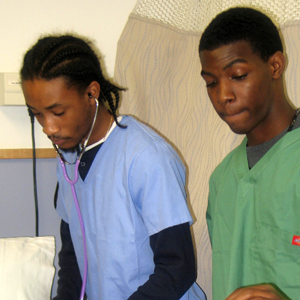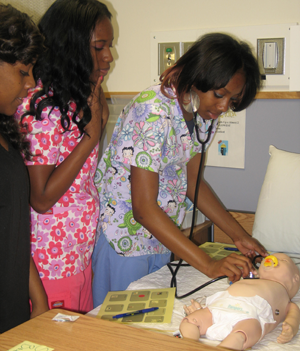High School Students Get Hands-on Practice at Drexel’s Clinical Simulation Center
November 16, 2011
 A group of 33 Philadelphia high school students visited Drexel this week to get hands-on practice with healthcare tools and techniques. At the Center for Interdisciplinary Clinical Simulation and Practice, the students practiced checking vital signs, administering medication, preparing for surgery and more.
A group of 33 Philadelphia high school students visited Drexel this week to get hands-on practice with healthcare tools and techniques. At the Center for Interdisciplinary Clinical Simulation and Practice, the students practiced checking vital signs, administering medication, preparing for surgery and more.
The students, from Imhotep Institute Charter High School, have been studying biology, anatomy and physiology, as well as exploring health professions. The school’s Health Academy track, just begun last year at Imhotep, gives students an opportunity to focus their learning on health topics from 10th through 12th grades. Visits to Drexel and other university and healthcare settings help students learn outside the classroom.
 “It’s one thing to sit, read and go through a textbook,” said Michelle Kellum, academy coordinator at Imhotep. “But doing it hands-on you really learn the skills.”
“It’s one thing to sit, read and go through a textbook,” said Michelle Kellum, academy coordinator at Imhotep. “But doing it hands-on you really learn the skills.”
Working in small groups, students rotated through eight stations in the Drexel simulation lab, where staff members introduced them to a variety of clinical scenarios and skills. After successfully completing the skills at each station, students received a stamp on a Drexel Clinical Skills “Passport” created for their visit.
For one Imhotep student named Shakera, who wants to be a neurosurgeon or neurologist, the Operating Room was the best part because it put her knowledge to the test. She and her classmates were challenged to reassemble a puzzle-like manikin patient whose abdominal cavity had been emptied. “I was surprised to find there were parts I didn’t know when I saw them,” she said. She also valued learning about some of the practical aspects of surgery, such as properly putting on a mask and gloves, and cleanup techniques.
Needles were the best part of the experience for another student, Tiara, who is interested in a career as a pediatrics nurse. At the medication station, she and her peers practiced assembling needles (blunt versions used for training), drawing medicine, injecting medicine into an orange and properly disposing of the needle in a biohazard bin.
At other stations, the students practiced performing vision tests, taking a patient’s vital signs on advanced, lifelike manikins, performing neurological assessments and more.